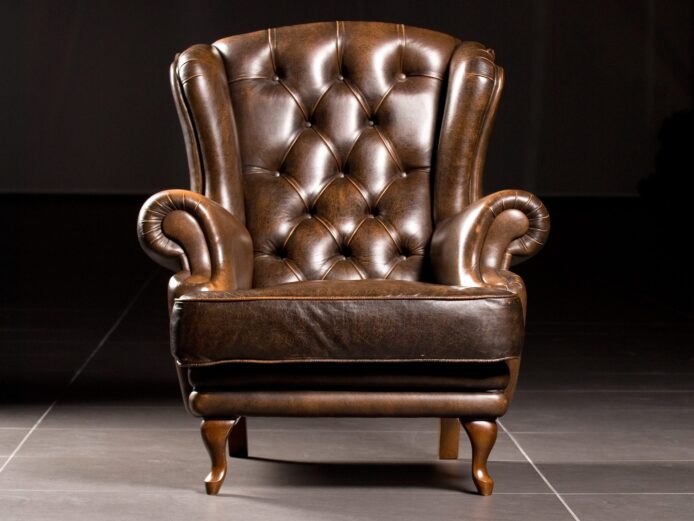Leather Techniques and Terms


Types of Leather Terms
ANILINE LEATHER
About 5 percent of any leather upholstery that’s produced falls into this category. When aniline dyes are used to on leather, this is what we call it. Often waxed, or treated with a protective lacquer, protein, or resin coating
ANTIQUED
Also referred to as distressed leather; this is leather which has been dyed with multiple colors on after the other for the purpose of creating artificial aging and prestigious highlights.
CHROME TANNAGE
This is presently the most commonly type of tannage in use in the USA. It’s the use of chromium salts to achieve mellow, soft hides that will more easily absorb a variety of colors.
COMBINATION TANNAGE
Using more than a single tanning agent on leather to give it more softness and body.
CONDITIONING
Using products to rehydrate and revitalize leather and help it keep itself together and support good quality.
CORRECTED GRAIN
Leather which is first abraded or sanded in order to remove faults, then pigmented to hide the sanding after which an artificial grain is printed on it. It is also referred to as top grain leather.
CROCK
What we call it when color gets rubbed off leather which has been dyed poorly.
DISTRESSED
Otherwise known as antiqued leather.
DRUM DYING
Immersing leather in a drum with dye stuff and tumbling the drum, allowing the dye to fully penetrate the leather
EMBOSSED LEATHER
Applying a pattern to leather through use of intense pressure often used to imitate the characteristics of full grain on corrected grain. Leathers are often embossed to give one type of leather the appearance of another.
FAT WRINKLE
Imitation leather lacks fat wrinkles. They are the wrinkles that animals’ fat deposits cause which give leather its rustic and beautiful appearance.
FINISH
A substance applied to the leather’s surface to mask imperfections, protect and/or color leather. This term can be used for any processing done to leather after tanning.
FULL GRAIN
Unaltered or uncorrected hide or skin once the hair is removed.
GLAZED FINISH
When the surface of the leather is polished using enormous pressure with glass on steel rollers. Besides this, it’s almost the same as an aniline finish.
GRAIN CHARACTER
Leather’s natural surface markings.
GRAINED LEATHER
Any leather on which the original natural grain has been changed or altered by any method, process or manipulation; also top grain.
GRAIN SUEDED
Leather in which the grain has been sueded for the purpose of getting a buffed appearance.
HAND
A word describing suppleness or softness of leather. A common term in the leather industry.
LEATHERETTE
A leather imitation, or faux leather fabric material.
MATTE FINISH
A finish without shine.
NAKED LEATHER
A term used to describe leather which has only been dyed without any other finish or treatment.
NAP
The soft effect found after brushing or buffing leather.
NATURAL GRAIN
The original full grain retained in the leather
NUBUCK
Grain suede leather which has been brushed.
OIL TANNED
A pliable, soft leather tanned with fish oils.
PATENT LEATHER
When varnish, synthetic resins, or drying oils are used with successive coats on leather to get an impermeable glossy finish.
PATINA
When something looks beautifully grown on the surface through use or age; a quality achieved through habit, repetition, or constant use.
PERFORATED
Leather with a pattern of holes cut into it.
PIGMENTED LEATHER
When a flat surface color is added to leather to increase durability and mask blemishes.
PLATING, PLATED LEATHER
Using a heated metal plate to press leather. Plating, pigmenting, and sanding are most often used to cover imperfections in furniture leather.
PULL-UP
Areas of treated leather becoming lighter when stretched or pulled, particularly treated with dyes, waxes, and oils. This is seen as a sign of excellent quality.
RECONSTITUTED LEATHER
A fibrous mat put together using collagen fibers from macerated pieces of hide.
REFINISHING
Covering stains, correcting fading, and hiding damage trough applying finish to leather. Can also be used to change the color of leather.
REPAIR
Correcting minor damage through the use of synthetic filler materials.
SEMI-ANILINE
When a matching layer of pigment is added to aniline leather for the sake of protection and/or evening out the color.
SHRUNKEN GRAIN LEATHER
Enhancing the grain of a natural, full-grain leather by shrinking it.
SIDE
A lengthwise cut down the middle of a hide making a half.
SPLIT LEATHER (SPLIT)
Sliced hide with each layer done in equal thickness. Sometimes cheap leathers are just pigmented splits with imitation grain embossed. Can also be finished and trimmed as
suede.
SPOT REFINISHING
Covering isolated damage in small areas by applying finish.
STAINGUARDING
Enhancing unfinished leather’s resistance to stain penetration through the temporary application of and invisible film.
SUEDE
Producing a nap by finishing through buffing the flesh side. This term only refers to the process of napping, and has doesn’t indicate why type of hide
is used.
TANNIN
Leather tanning substances made from plants.
TOP GRAIN
Genuine grain leather, not embossed or pigmented.
TWO-TONE
Layers of dyes (either contrasting or similar) applied to leather to make an aged or mottled appearance.
Two examples of two-tone leathers are Sauvaged and Antiqued leathers.
UNFINISHED LEATHER
Naked, aniline-dyed leathers with no added treatments or colors to alter the look or feel of the leather.
UPHOLSTERY LEATHER
Leather used in car seats, furniture, and airplanes.
VAT DYEING
A method of dyeing dating a long way back. Not to be confused with drum dyeing.
VEGETABLE TANNING
Using organic materials for tanning as opposed to the usual chemicals. Generally has better firmness and greater body than leather which is traditionally tanned.
WEIGHT
Ounces per square foot are used to weigh leather.
WHOLE HIDE
Usually used for upholstery, whole hide uses the full hide instead of just a side.
